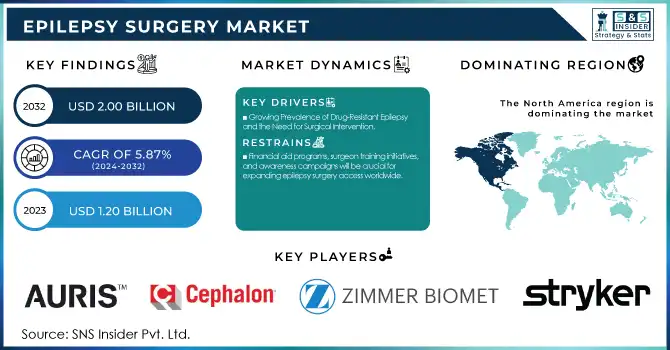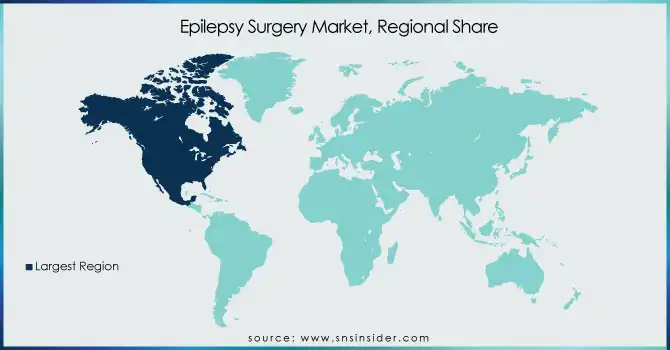Epilepsy Surgery Market Size & Overview:
The Epilepsy Surgery Market Size was valued at USD 1.20 billion in 2023 and is expected to reach USD 2.00 billion by 2032 and grow at a CAGR of 5.87% over the forecast period 2024-2032.

Get more information on Epilepsy Surgery Market - Request Sample Report
The report examines the rising incidence and prevalence of epilepsy, driving the demand for surgical treatments across various regions. The report highlights trends in epilepsy surgery, including the adoption of advanced techniques, and looks into healthcare spending on epilepsy surgeries by region, emphasizing differences in funding and accessibility. It also addresses the availability of specialized surgical centers and experts, which is crucial for improving patient outcomes.
Epilepsy Surgery Market Dynamics:
Drivers
-
Growing Prevalence of Drug-Resistant Epilepsy and the Need for Surgical Intervention
One of the major driving forces for the epilepsy surgery market is the growing prevalence of drug-resistant epilepsy, affecting about 30–40% of epilepsy patients, who fail to gain seizure control even with the optimal anti-seizure medication therapy. It is also termed medically intractable epilepsy. Patients suffering from this condition are left with fewer options for treatment, which heavily handicaps them and increases their chances of suffering sudden unexpected death from epilepsy (SUDEP). As reported by the World Health Organization, epilepsy affects about 50 million people around the world, and most of these people have a considerable chance of being treated by surgical intervention.
Technological progress has streamlined the process of the least invasive, latest investigations in surgery regarding epilepsy. Robot-assisted surgery, particularly with the ROSA robotic system, offers enhanced precision of stereoelectroencephalography (sEEG) electrode placement, which is a critical step in diagnosing and treating epilepsy. LITT, or laser interstitial thermal therapy, is a minimally invasive procedure guided by MRI that has gained popularity as an alternative to open resections, especially in mesial temporal lobe epilepsy (MTLE). Other options for neuromodulation are responsive neurostimulation (RNS) from NeuroPace and vagus nerve stimulation (VNS) therapy, offering non-respective alternatives to patients who do not make the ideal candidates for traditional surgery. Increased awareness and early diagnosis campaigns by organizations like the Epilepsy Foundation, the International League Against Epilepsy (ILAE), and the National Association of Epilepsy Centers (NAEC) have added more patients to the pool of potential surgical patients.
Restraints
-
Financial aid programs, surgeon training initiatives, and awareness campaigns will be crucial for expanding epilepsy surgery access worldwide.
High costs are a major obstacle, especially in LMICs, where the average cost of epilepsy surgery varies between USD 20,000 and USD 50,000, which is often more than the average annual household income. Limited accessibility to specialized centers with special epilepsy facilities also hampers its treatment availability. For example, in sub-Saharan Africa, one center in every 50 million people exists, while in high-income countries, one in every 5 million people exists. There is also a setback for untrained neurosurgeons and epileptologists. According to the report of the World Federation of Neurology, many LMICs have less than one neurologist for 100,000 people, and also, for most patients, epilepsy surgery is still an unrealistic option due to the risks involved with surgery: cognitive impairment, infections, and memory loss. Generally, studies have shown that epilepsy surgery has a success rate of 50-80%.
Opportunities
-
Emerging markets are playing a critical role in improving patient care, and fostering innovation in cutting-edge neurosurgical technologies.
The epilepsy surgery sector has significant growth opportunities in emerging markets, especially due to increasing investments in healthcare infrastructure across Asia-Pacific and Latin America. India has established over 20 specialized epilepsy centers to improve access to surgical interventions for drug-resistant epilepsy patients. Similarly, Brazil has launched national epilepsy surgery programs that have expanded treatment options for the underserved. The use of minimal invasiveness in surgery by adopting MRI-guided laser ablation, often referred to as LITT, is increasingly getting popular because the recovery time is minimized, complications minimized, and there is a much shorter stay at the hospital. Clinical studies found that LITT achieves more than 60 percent seizure freedom in focal epilepsy cases, making the alternative to an open surgery suitable. China, and Mexico, are some of those countries that assimilated LITT into their neurosurgical service programs, to expose more patients to such advanced processes. Furthermore, increased funding for neurological research and clinical trials has been fueling innovation in the treatment of epilepsy. NIH and international epilepsy foundations are working on advancements in robot-assisted surgery, DBS, and RNS that have improved the precision and outcomes for patients. Clinical trials have begun in Mexico and Argentina intending to expand indications for surgical intervention based on neuromodulation techniques.
Challenges
-
Its adoption is hindered by factors such as limited awareness, complex patient selection, and lack of access to necessary infrastructure.
The studies indicate that only 1% to 2% of the eligible patients go for surgical intervention. Almost 30% of the patients suffering from epilepsy are drug-resistant and are potential candidates for surgery. A major reason is lacking awareness among the patients and also among the doctors. Most neurologists refer the patient for surgery a bit too late or not at all because they seem to have several misconceptions about it. According to research published in Neurology, the median delay from the onset of epilepsy to surgery exceeds 20 years, which may largely reduce the potential benefits of early intervention. The other crucial challenge is the complexity of patient selection and pre-surgical evaluation that involves comprehensive testing including video EEG monitoring, high-resolution MRI, PET scans, and neuropsychological assessments. These assessments require interdisciplinary teams, consisting of epileptologists, neurosurgeons, radiologists, and neuropsychologists, which are not available in most healthcare settings, especially in LMICs. For example, a survey of epilepsy centers in sub-Saharan Africa reported that less than 10% had the infrastructure to support epilepsy surgery programs.
Epilepsy Surgery Market Segmentation Analysis
By Procedure Type
In 2023, the Laser Interstitial Thermal Therapy (LITT) segment dominated the Epilepsy Surgery Market, holding 48.9% of the market share. Being a minimally invasive procedure with decreased recovery time and complications when compared to standard surgery, it is preferred among both patients and healthcare givers. In LITT, the laser destroys parts of the brain tissue associated with seizures in focal drug-resistant epilepsy.
Despite its dominance, Resective Surgery is the fastest-growing segment. This method of removal of brain tissue causing seizures is effective for localized drug-resistant epilepsy and results in significant improvement. Advances in presurgical diagnostics such as advanced imaging and monitoring techniques have improved the outcomes of resective surgeries, thereby increasing the adoption and growth of this segment, especially among patients with well-defined focal epilepsy.
By End User
The Hospitals & Clinics segment dominated the epilepsy surgery market in 2023 with a market share of 65.9%. Hospitals and clinics are the common sites for most epilepsy surgeries. They provide patients with all forms of pre-surgical, surgical, and post-surgical follow-ups- for comprehensive treatment of epilepsy. All the necessary, specialized equipment can be found within hospitals, accompanied by a multi-disciplinary team that can easily handle complex epilepsy cases and even offers a large range of treatment options, which include resective surgery and deep brain stimulation.
The Specialty Centers segment is the fastest-growing within this market. Such specialty centers provide highly specialized care and treatments, including advanced technologies like responsive neurostimulation and laser interstitial thermal therapy. With the increasing demand for personalized and targeted care, specialty centers are gaining more popularity, especially for patients who require focused epilepsy treatment options. Their ability to provide dedicated epilepsy care is driving their fast-paced growth in the market.
Regional Analysis
North America was the largest market, accounting for a large share of the global share in 2023 on account of high awareness, advanced medical technologies, and well-developed healthcare infrastructure. The United States has several world-class epilepsy centers and serves as a hotbed for newer treatments such as Laser Interstitial Thermal Therapy (LITT) and responsive neurostimulation. Reimbursement policies are also quite favorable within this region.
In Europe, the market is also growing steadily, leaders in this region include Germany, France, and the UK. European countries are becoming more interested in less invasive surgeries because patients can receive more advanced diagnostic measures and surgical technology. Regional disparities in access to some forms of care and reimbursement in certain European countries, however, restrict growth a little.
The Asia-Pacific region is poised to be the growth leader in the market due to increasing healthcare investments, raising awareness, and improving accessibility to advanced medical care. Countries like China, India, and Japan are also experiencing an upsurge in people suffering from epilepsy, thus maintaining demand for surgical treatments. However, despite the challenges of limited access to specialized centers in rural areas, the infrastructure and awareness-building campaigns seem to be pushing the market growth forward.

Need any customization research on Epilepsy Surgery Market - Enquiry Now
Key Players:
-
Stryker - Neurovascular Products, Neuro Navigation Systems
-
Zimmer Biomet Holdings Inc. - Mazor Robotics, Robotic-Assisted Surgery Systems
-
Auris Health Inc. (Hansen Medical Inc.) - Auris Surgical Robotics System
-
Intuitive Surgical - da Vinci Surgical System
-
Medtronic Plc (Mazor Robotics) - Mazor X Stealth, Responsive Neurostimulation (RNS)
-
Cephalon Inc. - Acthar Gel
-
CMR Surgical - Versius Surgical Robot
-
Natus Medical Incorporated - EEG Monitoring Systems, Intraoperative Neuromonitoring (IONM) Systems
-
Livanova Plc - Vagus Nerve Stimulation (VNS) Therapy
-
Monteris Medical - NeuroBlate System
Recent Developments:
In July 2024, Cleveland Clinic Abu Dhabi, a part of the M42 group, achieved a significant milestone by performing the UAE's first stereoelectroencephalography (SEEG) procedure. This minimally invasive technique is designed to precisely locate the origins of difficult-to-treat focal epileptic seizures in the brain, marking a major advancement in the region's epilepsy treatment capabilities.
| Report Attributes | Details |
|---|---|
|
Market Size in 2023 |
USD 1.20 Billion |
|
Market Size by 2032 |
USD 2.00 Billion |
|
CAGR |
CAGR of 5.87% From 2024 to 2032 |
|
Base Year |
2023 |
|
Forecast Period |
2024-2032 |
|
Historical Data |
2020-2022 |
|
Report Scope & Coverage |
Market Size, Segments Analysis, Competitive Landscape, Regional Analysis, DROC & SWOT Analysis, Forecast Outlook |
|
Key Segments |
• By Procedure Type [Resective Surgery, Laser Interstitial Thermal Therapy (LITT)] |
|
Regional Analysis/Coverage |
North America (US, Canada, Mexico), Europe (Eastern Europe [Poland, Romania, Hungary, Turkey, Rest of Eastern Europe] Western Europe] Germany, France, UK, Italy, Spain, Netherlands, Switzerland, Austria, Rest of Western Europe]), Asia Pacific (China, India, Japan, South Korea, Vietnam, Singapore, Australia, Rest of Asia Pacific), Middle East & Africa (Middle East [UAE, Egypt, Saudi Arabia, Qatar, Rest of Middle East], Africa [Nigeria, South Africa, Rest of Africa], Latin America (Brazil, Argentina, Colombia, Rest of Latin America) |
|
Company Profiles |
Stryker, Zimmer Biomet Holdings Inc., Auris Health Inc. (Hansen Medical Inc.), Intuitive Surgical, Medtronic Plc (Mazor Robotics), Cephalon Inc., CMR Surgical, Natus Medical Incorporated, Livanova Plc, and Monteris Medical. |

